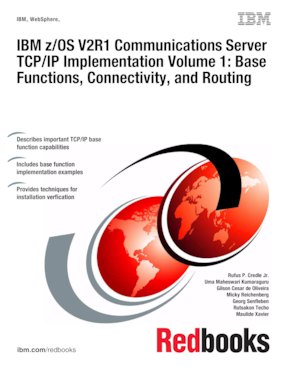About cookies on this site Our websites require some cookies to function properly (required). In addition, other cookies may be used with your consent to analyze site usage, improve the user experience and for advertising. For more information, please review your options. By visiting our website, you agree to our processing of information as described in IBM’sprivacy statement. To provide a smooth navigation, your cookie preferences will be shared across the IBM web domains listed here.

Published on 18 December 2013, updated 04 May 2015
Read in Google Books Order hardcopy
Share this page:
ISBN-10: 0738438839
ISBN-13: 9780738438832
IBM Form #: SG24-8096-00
Authors: P. Rufus Jr. Credle, Uma Maheswari Kumaraguru, Gilson Cesar de Oliveira, Micky Reichenberg, Georg Senfleben, Rutsakon Techo and Maulide Xavier
Abstract
For more than 40 years, IBM® mainframes have supported an extraordinary portion of the world's computing work, providing centralized corporate databases and mission-critical enterprise-wide applications. IBM System z®, the latest generation of the IBM distinguished family of mainframe systems, has come a long way from its IBM System/360 heritage. Likewise, its IBM z/OS® operating system is far superior to its predecessors in providing, among many other capabilities, world-class, state-of-the-art support for the TCP/IP Internet protocol suite.
TCP/IP is a large and evolving collection of communication protocols managed by the Internet Engineering Task Force (IETF), an open, volunteer organization. Because of its openness, the TCP/IP protocol suite has become the foundation for the set of technologies that form the basis of the Internet. The convergence of IBM mainframe capabilities with Internet technology, connectivity, and standards (particularly TCP/IP) is dramatically changing the face of information technology and driving requirements for even more secure, scalable, and highly available mainframe TCP/IP implementations.
The IBM z/OS Communications Server TCP/IP Implementation series provides understandable, step-by-step guidance for enabling the most commonly used and important functions of z/OS Communications Server TCP/IP.
This IBM Redbooks® publication is for people who install and support z/OS Communications Server. It introduces z/OS Communications Server TCP/IP, describes the system resolver, showing implementation of global and local settings for single and multi-stack environments. It presents implementation scenarios for TCP/IP base functions, connectivity, routing, virtual MAC support, and sysplex subplexing.
Table of Contents
Chapter 1. Introduction to Communications Server for z/OS IP
Chapter 2. The resolver
Chapter 3. Base functions
Chapter 4. Connectivity
Chapter 5. Routing
Chapter 6. VLAN and virtual MAC support
Chapter 7. Sysplex subplexing
Chapter 8. Diagnosis
Chapter 9. z/OS in an ensemble
Appendix A. IPv6 support
Appendix B. Additional parameters and functions
Appendix C. Examples used in our environment
Appendix D. Our implementation environment